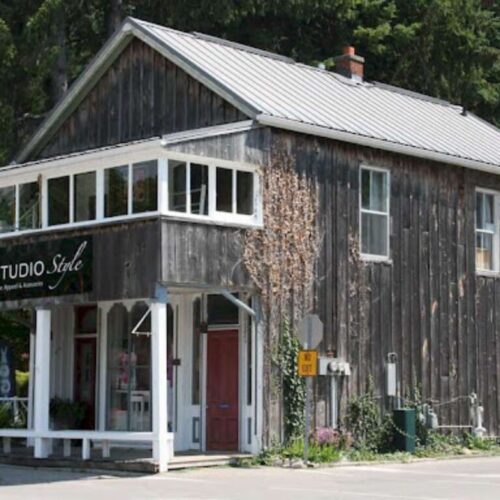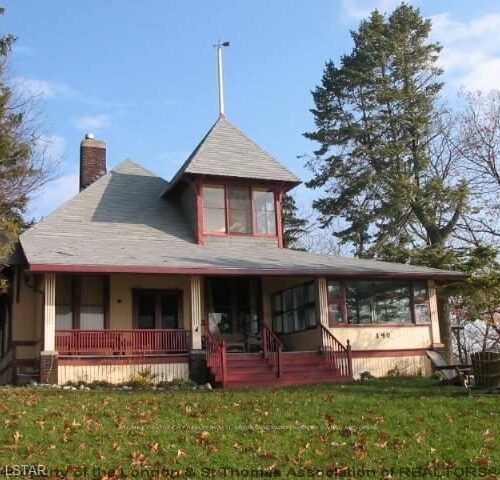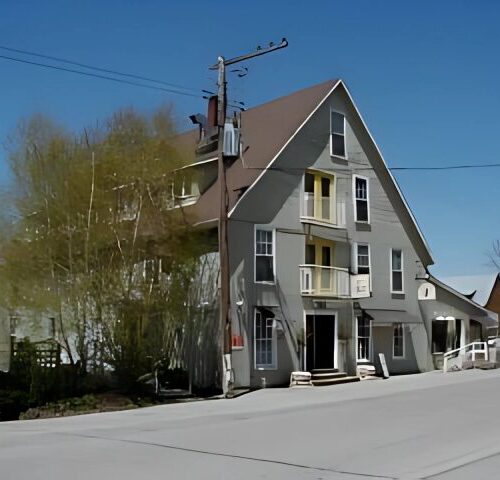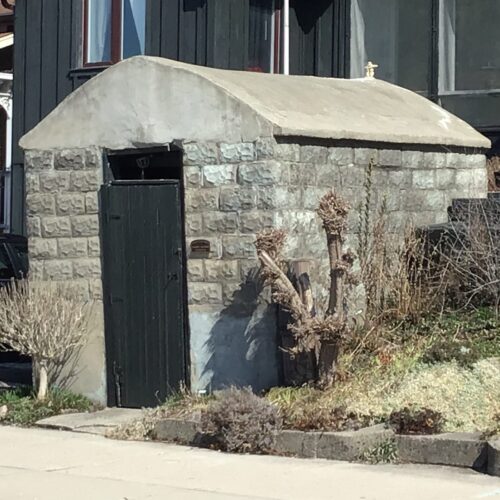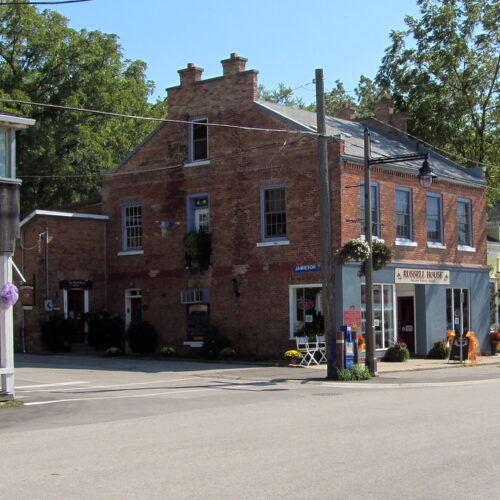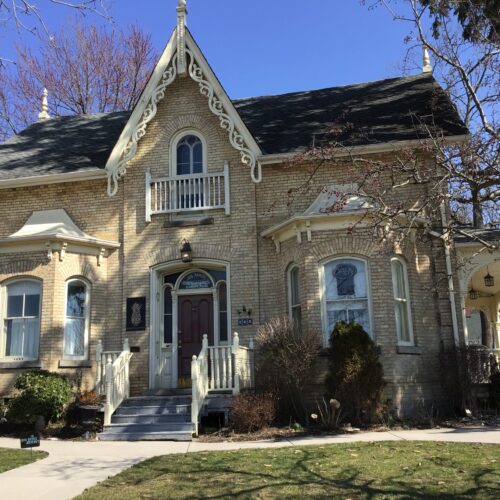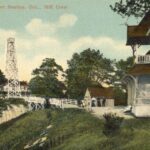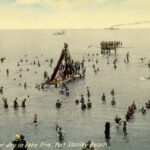- Russell House
The Russell House, also known as the Sweeney House, is one of Port Stanley’s oldest surviving structures, located at 211 Main Street. Built in the early 1870s from locally produced “strawberry bricks,” the building originally operated as a hotel, serving travelers arriving by rail and lake.
- Telegraph House
The Telegraph House, built in 1873 by Manuel Payne on the original foundation of Col. John Bostwick’s home, is an early Victorian yellow brick residence blending Gothic Revival gables with Italianate bay windows and quoining, and was home to Payne, Port Stanley’s first postmaster and a key civic figure.
- Cork Kiln
Built circa 1915 during the boom of Port Stanley’s fishing industry, the Cork Kiln played a vital role in drying cork for use as floats in fishing nets. Constructed into the side of the hill for natural dry heat, it remains a rare surviving example of early industrial ingenuity along Ontario’s coast.
- Harbour House
Built circa 1917 by the East Side Fish Company, Harbour House was used for net mending and storage rather than fishing. Its large, windowed design captured natural light and heat, reflecting early adaptation to industrial needs.
- Livery Stable
Built in the 1870s, the building originally served as a livery stable, a boarding and care facility for horses and carriages used by travelers and villagers. Heritage records confirm the address in Port Stanley’s heritage by-law, emphasizing its historical role in transportation and commerce.
- Kettle Creek Inn
Kettle Creek Inn at 216 Joseph Street, Port Stanley, is a historic stone home-turned-inn featuring two guest wings, a courtyard, garden gazebo, and patio, perfect for relaxation by the harbor. Built in 1849 and converted to an inn in 1918, it blends vintage charm with modern comfort.
- Morrow House
Morrow House is a charming late‑Victorian heritage home located at 232 Colborne Street, Port Stanley, Ontario. It features a steeply pitched roof, bay windows, ornate wood trim, and a welcoming front porch, set among mature trees and a well‑kept garden.
- Windjammer Inn
Windjammer Inn at 324 Smith Street, Port Stanley, Ontario, is a beautifully restored 19th-century heritage home offering cozy accommodations and a renowned restaurant. Guests can enjoy wraparound porches, a well-appointed bar, and a lush garden patio overlooking Lake Erie.
- Port Stanley Breakwater Lighthouse
The Port Stanley Breakwater Lighthouse was designated a heritage lighthouse in 2016 under the Heritage Lighthouse Protection Act. This iconic structure has served mariners for over a century and symbolizes Port Stanley’s strong economic connection to Lake Erie.
- Rustico House
Rustico House is a substantial historic home located in the Invererie Heights area of Port Stanley, Ontario. Built around 1870 or 1871 by William Fraser, this elegant summer retreat features a distinctive long gallery that stretches across the front of the house and extends partway down each side.
- Alma Villa
Alma Villa is a historic late 19th-century residence at 201 Lakeview Avenue, Port Stanley. It features a spacious porch, intricate woodwork, and large windows that frame views of the neighborhood and nearby Lake Erie.
- Selbourne Mill
Selbourne Mill is a historic water-powered grist mill at 181 Brayside Drive, Port Stanley. This sturdy stone building reflects the village’s industrial heritage and the importance of milling to the local economy in the 19th and early 20th centuries.
- Brayside Log Cabins
Brayside Log Cabins are a charming collection of rustic cabins located at 191 Brayside Drive in Port Stanley, Ontario. Nestled near the waterfront, these cabins offer visitors a peaceful retreat surrounded by natural beauty, combining historic log construction with modern comforts.
- Bostwick House
Bostwick House at 216 Cornell Drive, Port Stanley, was built in 1827 by Colonel John Bostwick. Its rare brick nogging construction features oak beam framing filled with handmade clay bricks, one of only two known examples in Ontario.
- Liberty Hill Club
Liberty Hill Club, established in 1900, is a historic private club at 190 Cornell Drive, Port Stanley. Founded by local businessmen, it was created as a social space to promote liberty, leisure, and community among its members.
All Listings
This whimsical building may be the oldest structure in the village, and has been a livery,a confectionary shop, aretail store, and temporarily the Village Hall. Its large display windows in the front, distinctive features, and main location has always kept the Livery Stable at the hub of village life.
This unique structure was built in 1896 by J. A. Robinson of St. Thomas. It was designed by renowned St. Thomas architect J. Z. Long as a club house for a development on Hillcrest. Hillcrest was also known as Liberty Hill and this development was one of the earliest resort developments in Port Stanley. The building has a hip roof that is shingled with cedar shakes. It also features two gables facing east and west with a dormer window in their center. It is a one and a half story structure with a full basement accessible from a ramp on the north side and has a garage style opening that would accommodate large deliveries and vehicles.
The building was constructed circa 1917 by the East Side Fish Company, although it was not completed until after the fishing industry began to decline. It was never used as a fishery but served for net mending and storage. The symmetrical design and the number of windows provide east, south and west exposure to both natural light and the sun's heat in a large structure that was originally heated only by small coal stoves.
Built circa 1915 during the boom of the fishing industry, the cork kiln was important for the drying of the cork used for floating fish nets. The kiln was built into the side of the hill as a natural way to maintain dry heat.
The Russell house was built in the early 1870s of locally made strawberry bricks by a newly arrived settler, John Sweeney. It was one of the first hotels in Port Stanley, and one of a number of similar inns required in the early days of lake, rail and stagecoach travel. Over the years it has served as butcher and plumbing shops, and doctor's, lawyer's and insurance agent's offices. The building later became the Sterling Bank, and several staff members lived in rooms on the second floor. One of these staff included a young banker named Mitchell Hepburn, who later became Premier of Ontario.
The Payne House was built in 1873 by Manuel Payne on the site of Col. John Bostwick's residence, and encompasses its original foundation. Built of yellow brick in the early Victorian style, it mixes the gables of Gothic Revival and the bay windows and quoining of the Italianate style. Manual Payne was a railway agent, telegraph and telephone operator, customs officer, express agent, issuer of marriage licenses, and the first postmaster of the village.
- 1
- 2

